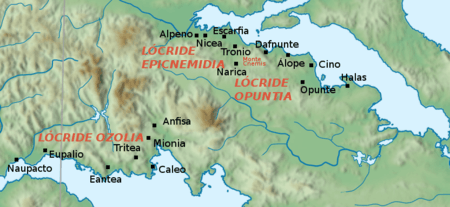Alope (Opuntian Locris)
Alope (Ancient Greek: Ἀλόπη, romanized: Alópē) was a town of Opuntian Locris on the coast between Daphnus (modern Agios Konstantinos) and Cynus (modern Livanates). Its ruins have been discovered by William Gell on an isolated hill near the shore in the modern village of Melidoni, Phthiotis (Greek: Μελιδόνι Φθιώτιδας).[1][2][3]

History
Concerning the history of the city, the Locrians were defeated by the Athenians under Kleopompos in 431 BCE nearby,[4][5] and the city was taken.[6] It suffered greatly from the terrible earthquake of 426 BCE, according to Demetrius Callatianus quoted by Strabo.[7][8]
References
- Richard Talbert, ed. (2000). Barrington Atlas of the Greek and Roman World. Princeton University Press. p. 55, and directory notes accompanying.
- Johannes Toepffer: Alope 2.(in German) In: Realencyclopädie der classischen Altertumswissenschaft (RE). Volume I,2, Stuttgart 1894, col. 1595.
-

- Thucydides. History of the Peloponnesian War. II.26.
- Diodorus Siculus. Bibliotheca historica (Historical Library). XII.44.
- P. Girard, De Locris Opuntiis (1881), p. 31
- Strabo. Geographica. I 60. Page numbers refer to those of Isaac Casaubon's edition.
- Johannes Toepffer: Alope 2.(in German) In: Realencyclopädie der classischen Altertumswissenschaft (RE). Supplement Volume III, Stuttgart 1918, col. 84 f.
![]()